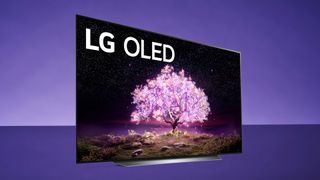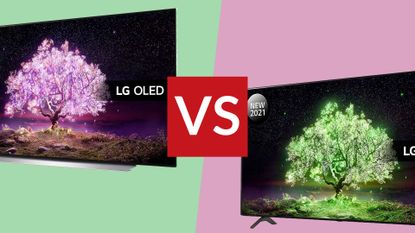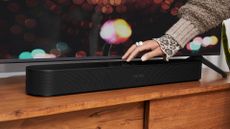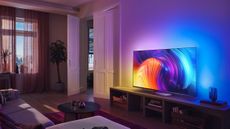The question of LG A1 vs LG C1 is a huge one if you're looking to buy an OLED TV right now. They're both among the best OLED TVs available right now, and both have great discounts among the best Black Friday sales, making them cheaper than they've ever been right now.
But the LG A1 is notable cheaper than the LG C1, though it's not easy to stop what all the differences are, so in this feature we'll explain what you need to know, and bring you the current best prices.
The LG C1 is one of our absolute favourite OLED screens with what we’ve officially called “sensational picture quality” in our full LG C1 review. Its HDMI 2.1 functionality for playing nicely with PlayStation 5 and Xbox Series X means it also sits at the top of the list of our best gaming TVs.
The LG A1 on the other hand is LG’s cheapest OLED for 2021. It’s still got that OLED panel for inky blacks and richer colours than a standard LED set, but there are a few key feature differences. Don't forget that we also have our LG A1 vs LG B1 guide if you just want to focus on the cheaper OLED models.
Take a look at our Black Friday OLED TV Deals page and keep an eye on our best Black Friday TV sales for more TV reductions. We also have specific round ups for each manufacturer so you can check by brand.

The LG A1 may be less expensive, but it still looks classy.
LG A1 vs LG C1: Price and models
The price of OLED screens has dropped dramatically over the last few years but that still doesn’t bring them anywhere near our best TVs under £500. And, as if proving that point, the entry level LG A1 is still a premium price overall, especially if you’re planning to go bigger than the 48-inch model and are restricted by your wallet.
There are lots of price reductions as the year comes to a close, but the official price of the LG A1 is as follows: the exceptionally well-sized 48-inch option is £999/$1300, the 55-inch model is £1099/$1600, the 65-inch is £1599/$2200, and the 77-inch model is sitting at £2999/$3200.
Here are today's discounts on all those sizes, though:
The LG C1 is available in the same sizes, with a bonus wall-filling 83-inch option. Again, these have had reductions over the year and are getting more discounts during sale season, but here's the official price from LG's sites: the 48-inch model is £1,099/$1,499, the 55-inch version is £1299/$1799, the 65-inch is £1899/$2099, 77-inch £3499/$3299, and the 83-inch is looking much more expensive in the UK than the US at £6,999/$5,999.
Here are the latest LG C1 prices from retailers around the web:
If you’re looking at the 48-inch model, the price difference is small enough that the bigger investment can really change things here, especially if you’re looking to get a new-gen console. Go bigger though and obviously the LG A1 will give you much more OLED screen real estate for your money.

The LG C1 is packed with the latest features.
LG A1 vs LG C1: Picture quality
The first big difference between the LG A1 and LG C1 is the refresh rate of the OLED panel. The LG A1 supports a 60Hz refresh rate, while the LG C1 doubles that to 120Hz. This doesn’t automatically mean that the LG A1 is terrible, just that it doesn’t support the high frame rates most desired by gamers. The LG A1 will still make movies look brilliant but if you’re looking for a smooth refresh rate for a PS5 or an Xbox Series X, you’ll want to invest the extra in the LG C1.
Both panels offer the deep contrast with pixel precision than OLED is known for, but there’s another key upgrade for the LG C1; the processor. This is where the biggest leaps in picture performance over the last few years can easily be seen as manufacturers improve detail and motion handling. The LG A1 sports the LG A7 Gen4 Processor while the LG C1 has the A9 Gen 4 Processor. The A7 is no slouch, but the A9 is the processor that gave us pause for thought in our LG C1 review:
“The C1 delivers lots of ‘wow, that’s better than last year’ moments. Motion handling is particularly noteworthy, courtesy of some clever new image interpolation techniques. A Cinematic Movement option that controls the level of frame merging is particularly effective, and all but eliminates the horrid soap opera effect. There are seemingly small, but significant improvements to picture handling too.”
The LG A1 still has all of the colour vibrancy you’d want from an OLED set but if you’re a stickler for detail, the processing technology might just push you in the direction of the LG C1 – especially if you're going for a larger size, where any imperfections would be more obvious, especially from non-4K sources.
Generously though, both the A1 and C1 have Dolby Vision IQ which means that when you’re watching Dolby Vision content, the TV will use sensors to check the light in the room and adjust the brightness on screen accordingly. Both screens here are solid OLED performers then, it’s just a matter of that size/budget trade off.

The LG A1 has less powerful audio than the C1.
LG A1 vs LG C1: Sound quality
The sad fact of modern TV buying is the knowledge that the majority of purchases are going to need one of the best soundbars in order for the audio experience to match the one on screen. Rear- and downward- firing speakers combined with ultra thin screens ready to mount on walls means that the aural experience without a soundbar doesn't tend to be as epic as the image quality.
Sadly, this applies to both the LG A1 and the LG C1 but the LG C1’s 40W output does deliver on volume and, as our review says, the results are “sometimes surprisingly good.”
The LG A1’s output is 20W, but both screens do have LG’s proprietary AI Sound Pro technology built in. The Clear Voice Pro feature in both screens means that content with a mix that neglects the spoken word over sound effects, should feel significantly more balanced. The good news is that both the A1 and the C1 come with an eARC port for a soundbar so when that purchase comes along, you can wire it straight in via HDMI.
LG A1 vs LG C1: Design & features
Whether you buy the LG A1 or LG C1, you’re going to be investing in a beautifully slick screen. These are ultra thin panels of stylish brilliance, regardless of your choice. There is a key difference when it comes to the stand though and dependent on your furniture, this might make your decision for you.
The LG A1 has a foot at each end, while the C1 has a central stand so if your current stand has the screen significantly over the edges, you might want something with a central point of stability. Either way, there’s nothing that will aesthetically put you off the rest of the almost bezel free displays.
Ports-wise, it’s the connections here that will sway PS5/Xbox Series X gamers. All four of the LG C1’s HDMI ports are 2.1 standard which means the C1 supports 4K gaming at 120Hz, variable refresh rate (VRR), and auto low latency mode (ALLM). This makes the C1 an ideal partner for both the Xbox Series X and PS5.
Just to seal the controller-shaped deal, there’s also a new Game Optimiser Mode. As we said in our review, this “allows quick access to gaming specific features and requisite tweaks to brightness, VRR and so on. Game Genre selection, which applies picture processing based on play style, is particularly useful, with slightly different processing applied depending on whether you’re playing an FPS, RTS or RPG, so slower-paced games can have image quality boosted, and face-paced games can focus on response time.”
If none of that means anything to you then the three HDMI 2.0 ports on the LG A1 will absolutely do you nicely for general 4K HDR viewing use. As long as you don’t have too many boxes to plug in, this is a solid offering alongside two USB ports.
In terms of smart functionality, both the A1 and C1 deliver with the LG WebOS 6.0 operating system that makes it joyously easy to access streaming services. There are dedicated buttons for Netflix, Prime Video, and Disney+ on the included Magic Remote. Both screens also come with AirPlay 2 for easy streaming from Apple devices, and are equipped with both Alexa and Google Assistant. Smart function wise, LG has been generous with the LG A1 which feels feature rich at this slightly lower price point.
LG A1 vs LG C1: Verdict
If you’re the owner of a new-gen console, then the choice here is a no brainer as the LG C1 delivers everything you’ll ever need. If you don't have one now, but plan to get one in the future, then you should seriously think about the LG C1 as the future-proofed option, even if you don't need these features right now. And beyond gaming, the LG C1 also offer subtly (but notably) improved image quality of the two models.
But if you’re looking for the biggest LG OLED for your money and don’t mind the lower refresh rate and processor difference, the LG A1 will still deliver the rich contrast and colour you want from the investment.











